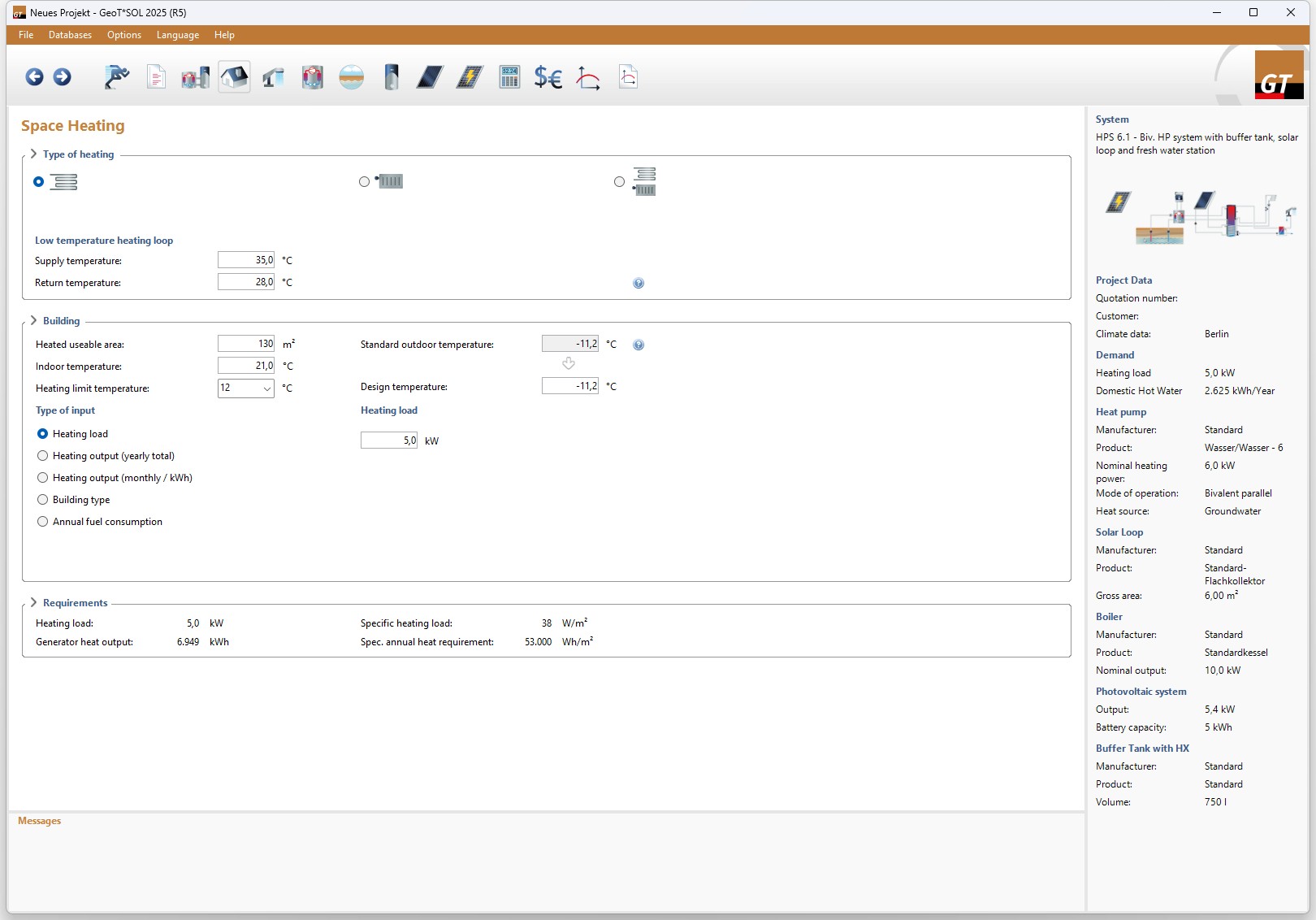Proceed as follows:
Type of heating
-
Select the space heating loop
-
 -> Underfloor heating, low-temperature space heating loop (LT)
-> Underfloor heating, low-temperature space heating loop (LT) -
 -> Radiators, high-temperature space heating loop (HT)
-> Radiators, high-temperature space heating loop (HT) -
 -> Underfloor heating and radiators
-> Underfloor heating and radiators
Enter the low-temp. (LT) heating loop proportion. Valid is: HT + NT = 100%.
-
-
The supply and return temperatures are set by default. You can change the values.
Space-heating loop T supply T return LT 35 °C 28 °C HT 50 °C 35 °C Note: A HT space heating loop can only be selected if it is connected to the heat pump via a buffer tank. Without a buffer tank, the heat pump will switch on and off permanently. In addition, the spread is greater than with NT systems.
Note: Systems whose heat pump is directly connected to the space heating can only be operated with LT space heating loops. The capacity of the underfloor heating has a similar effect as a buffer tank.
Building
Here you can define the building. You can perform the heating load calculation using another software and then import the data. Currently, files from SOLAR-COMPUTER GmbH can be imported. To do this, press Import data.
-
Define the heated usable area, the indoor temperature, and the heating limit temperature.
In the annual simulation, the relevant heating requirement is calculated from these design data, the respective outside temperature, and the irradiation. A warning is displayed in the event of undersupply.
-
The total resulting parameters of specific heating load (in W/m²) and specific annual heat requirement (in kWh/m²) are displayed at the bottom right.
-
The design temperature depends on the location. For Germany, the standard outdoor temperature is determined in accordance with DIN/TS 12831-1 from April 2020 and adopted directly as the design temperature.
For all other countries, the lowest outdoor temperature from the climate data set is displayed.
You can take over the displayed value or set the design temperature yourself. -
Define how the heating energy requirement is calculated:
-
 Heating load
Heating loadWhen selecting this option, the heating load (in kW) must be entered, and the heating output is then calculated from this.
-
 Heating output (yearly total)
Heating output (yearly total)When selecting this option, the yearly total heating output (in kWh) must be entered to calculate the heating load.
-
 Heating output (monthly / kWh)
Heating output (monthly / kWh)When selecting this option, the monthly heating output (in kWh) must be entered to calculate the heating load.
-
 Building type
Building typeUpon selecting this option, one must input information regarding building, year of construction, and type of renovation. The heating demand is determined based on this data. The data is sourced from the IEE Project TABULA (2009 - 2012). The data can be accessed through the TABULA WebTool. Currently, building types are categorized exclusively according to the German standard.
-
 Annual fuel consumption
Annual fuel consumptionWhen selecting this option, information about energy source, heat generator, and consumption must be entered.
-
Operation hours
- Here you can specify when the heating may be on and when it may be off. The colour green indicates that the heating is in operation for the respective month.
Grey indicates that the heating is not in operation for the respective month.
Pressing Details opens a dialogue in which you can define the daily operating times. By pressing the left mouse button and dragging the mouse, you can select several days.
Requirements
- The specific heating load (in W/m²) and specific annual heat requirement (in kWh/m²) are calculated and displayed at the bottom right. The annual simulation calculates the current heating demand based on these dimensioning parameters, considering the specific outdoor temperature and irradiation. A warning is displayed in case of undersupply.
